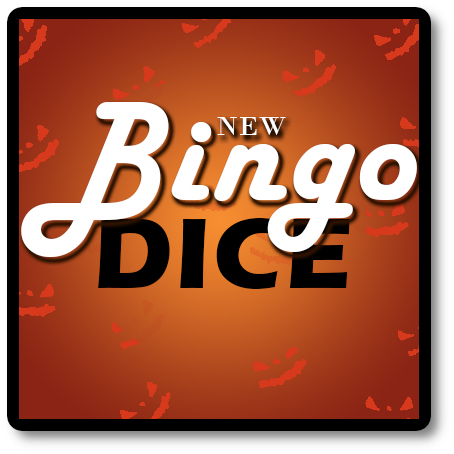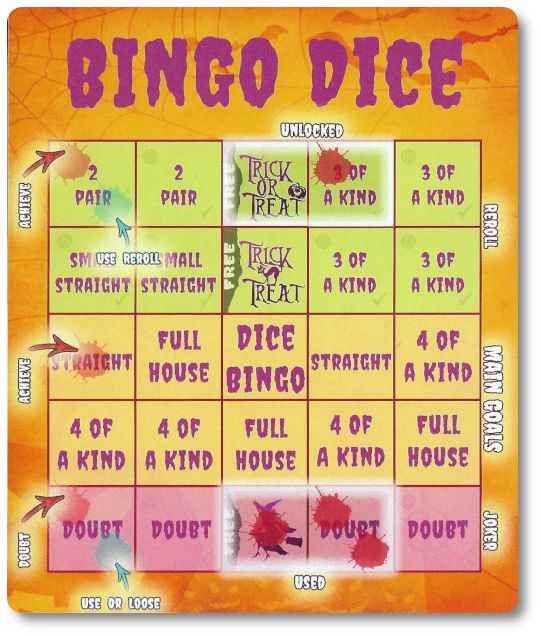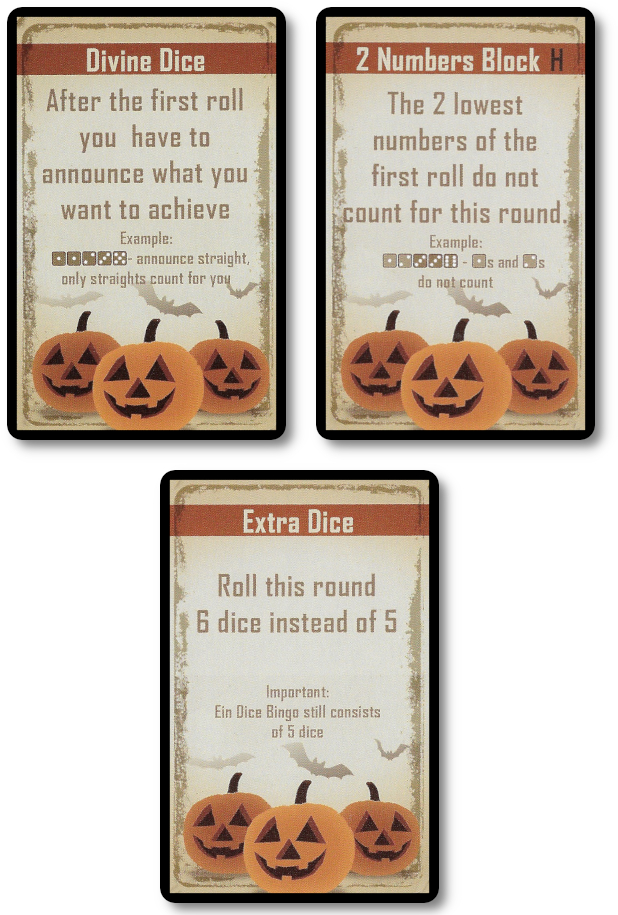Please Take Note: This is a review of the final game, but it might change slightly based on the success of the Kickstarter campaign. The game is being reviewed on the components and the rules provided with the understanding that “what you see is not what you might get” when the game is published. If you like what you read and want to learn more, we encourage you to visit the Kickstarter campaign. Now that we have all that disclaimer junk out of the way, on with the review.

The Basics:
- For ages 6 and up
- For 2 to 6 players
- Approximately 30 minutes to complete
Geek Skills:
- Active Listening & Communication
- Counting & Math
- Logical & Critical Decision Making
- Pattern Matching
- Risk vs. Reward
- Hand/Resource Management
Learning Curve:
- Child – Easy
- Adult – Easy
Theme & Narrative:
- If Yahtzee wanted to be like Bingo…
Endorsements:
- Gamer Geek rejected!
- Parent Geek mixed!
- Child Geek approved!
Overview
Indian politician, television personality and former cricketer, Navjot Singh Sidhu, said “One who doesn’t throw the dice can never expect to score a six.” Depending on the game (and the context), that is either a good thing or a bad thing. In the case of this game, you want a six, but not always. And when you want that six is critical to winning or making someone else lose. Pick up the dice and let them roll!
Bingo Dice, designed by Torsten Dinkheller and to be published by Mobile Game Design, will reportedly be comprised of four Bingo markers, 25 Scorecards, five standard six-sided dice, one First-Player marker, and one dice tray. As this is a review of a prepublished game, I cannot comment on the game component quality. The game is very limited as far as illustrations go, with the only artwork being present on the Scorecards. Our review copy was Halloween-themed (nice touch), but it’s not clear if this is the standard or part of the Kickstarter promotional. In either case, the theme here is on the surface only, with zero impact to game play.
Have a Seat, Take Some Dice…
To set up the game, first give each player one Scorecard and one Bingo marker. The game reportedly can take up to six players, but only four markers are provided (meaning players will have to share). Place the remaining Scorecards and any unused Bingo markers back in the game box.
Second, place the dice tray and dice in the middle of the playing area.
And that’s it…
Determine who the first player will be and give them the First-Player marker.
Lady Luck Doesn’t Smile; She Smirks…
Bingo Dice is played in turns with no set number of turns per game. A player’s turn is summarized here.
Step One: Roll Them Bones
The active player takes as many of the dice as they like and rolls them in the dice tray. The active player can reroll the dice up to three times or skip to step three if they choose not to or cannot take the action. When the game starts, each player is given two “Reroll” and one “Joker” actions for free. Once used, they are marked and the active player must earn more during the game. If they have them, they can use them or save them. A player is never forced to use what they earn.
Before the third roll, the opponent to the active player’s left (or the next player in turn order sequence) may state that they have a “Doubt”. A “Doubt” should be used if the opponent does not believe the active player will be able to use any of the dice to complete a “Main Goal” on the Scorecard.
If the active player insists on rolling a third time after a “Doubt” has been called, the opponent who called for the “Doubt” marks any unused box in their “Joker” row. The active player may now re-roll for a third time.
Which brings us to the Scorecard…
Unlike traditional Bingo, the Scorecard in Bingo Dice has specific rows. These are the “Reroll”, “Main Goal”, and “Joker”. A player marks (“achieves”) a box in a row by completing a specific combination of dice and values or winning a “Doubt” call. Some boxes give the player a special action (like the Reroll and the Joker). When unlocked, the player marks the upper-left of the box and when used they mark the lower-right.

Example of a Scorecard in use
Step Two: Doubting Thomas…
If the opponent to the player’s left called for a “Doubt”, this means the active player must now prove that they can achieve a box in the “Main Goal” rows by only using the dice. If they can, groovy! If not, bummer. Continue on. The opponent who called for the “Doubt” now gets a Joker they can use later on their turn by unlocking a Joker box by marking the upper-right corner.
Step Three: Score That Card
The active player now matches the dice values rolled to an open box on their “Main Goal” Scorecard rows by using the Bingo marker. These are not “unlocked”, so the player need only mark these boxes once.
If the player failed to earn a box using just their dice rolls after the third roll (awarding their opponent a “Joker”), the active player can now use a “Joker” they have previously unlocked if they like or a “Reroll”.
This completes the player’s turn. They now give the dice and the dice tray to the next player in the turn order sequence.
Winning the Game
The game continues as noted above until one player completes all the boxes in their “Main Goal” rows. All other opponents get one final turn before the game comes to an end, meaning all players have an equal number of turns.
The winners of the game are the players who have completed their Main Goals. This means one or more players could be declared the winner by the time the game ends.
Game Variant
Our review copy came with a small expansion, which includes 18 Rule cards and one black standard six-sided die. The rule cards are shuffled and placed face-down in the middle of the playing area, along with the black die. Unlike the base game described above, players now keep track of rounds. At the start of each round, a Rule card is drawn and revealed to all the players. The Rule card has a special rule that influences the current round. After the last player goes, the round ends, and the First-Player marker is passed to the next player in turn order sequences. The new First-Player now draws a new Rule card, discarding the previous Rule card. Thus changing the round with a new rule. The black die is used by the players if one of the Rule cards mentions it. Otherwise, it stays on the table and is not used.

To learn more about Bingo Dice, visit the Kickstarter campaign.
Final Word
 The Child Geeks enjoyed Bingo Dice, finding it fun to attempt to not only roll specific values, but making those around them feel that they couldn’t. According to one Child Geek, “I like the game because you can make the other players feel like they can’t roll the dice if you doubt them. I think that’s called head games.” Close, but the Child Geek describes it well enough to understand what is going on. When you play Bingo Dice, you are trying to not only roll what is needed, but also try to get your opponents to feel like you are hexing them. By “doubting”, you are essentially jinxing their roll. Depending on which end of the doubt you are on and the roll result, you’re either going to feel like a million dollars or like a chump. Another Child Geek said, “Easy game to play and fun to play. I like it because you do different things with the dice.” Yes, at first you can, but as the game progresses, the opportunities to use those rolls become fewer and fewer. But that never stopped the Child Geeks from having fun, resulting in this young group of enthusiastic players giving Bingo Dice their full endorsement.
The Child Geeks enjoyed Bingo Dice, finding it fun to attempt to not only roll specific values, but making those around them feel that they couldn’t. According to one Child Geek, “I like the game because you can make the other players feel like they can’t roll the dice if you doubt them. I think that’s called head games.” Close, but the Child Geek describes it well enough to understand what is going on. When you play Bingo Dice, you are trying to not only roll what is needed, but also try to get your opponents to feel like you are hexing them. By “doubting”, you are essentially jinxing their roll. Depending on which end of the doubt you are on and the roll result, you’re either going to feel like a million dollars or like a chump. Another Child Geek said, “Easy game to play and fun to play. I like it because you do different things with the dice.” Yes, at first you can, but as the game progresses, the opportunities to use those rolls become fewer and fewer. But that never stopped the Child Geeks from having fun, resulting in this young group of enthusiastic players giving Bingo Dice their full endorsement.
 The Parent Geeks had fun, but were not as enthralled as their younger counterparts. According to one Parent Geek, “The game is fun, but I don’t know why they called it Bingo Dice. You never say ‘bingo’ and you are only ever trying to complete a row.” Very true and this turned off a few of our players right from the start. The goal is to complete the requirements in the Main Goals. If you do, you win. In what order you complete them doesn’t matter in the slightest. Another Parent Geek said, “I think it is a good enough game to play when you are visiting with others, but it didn’t really grab my attention. Definitely a game I could play again when the people I’m with are more important than what I do on my turn.” Which is to say, the game is so casual, that one need not pay attention unless you are the active player or the next opponent after the active player. Otherwise, socialize all you like because what happens in the game has zero impact on your goals or decisions. The end result was the Parent Geeks putting as much interest in the game as the game put in them, giving Bingo Dice a mixed endorsement.
The Parent Geeks had fun, but were not as enthralled as their younger counterparts. According to one Parent Geek, “The game is fun, but I don’t know why they called it Bingo Dice. You never say ‘bingo’ and you are only ever trying to complete a row.” Very true and this turned off a few of our players right from the start. The goal is to complete the requirements in the Main Goals. If you do, you win. In what order you complete them doesn’t matter in the slightest. Another Parent Geek said, “I think it is a good enough game to play when you are visiting with others, but it didn’t really grab my attention. Definitely a game I could play again when the people I’m with are more important than what I do on my turn.” Which is to say, the game is so casual, that one need not pay attention unless you are the active player or the next opponent after the active player. Otherwise, socialize all you like because what happens in the game has zero impact on your goals or decisions. The end result was the Parent Geeks putting as much interest in the game as the game put in them, giving Bingo Dice a mixed endorsement.
 The Gamer Geeks hated the game. According to one Gamer Geek, “Junk. Yahtzee has more thinking in it and what you roll means something as everything has points. Nothing is important here or meaningful. From the dice you roll to how you score it.” Another Gamer Geek said, “The game requires too much effort for little reward. You should always roll three times and always say you doubt the opponent who is taking their turn. The dice are always random, so the results are always random, too. You lose as much as you win.” Although, the Gamer Geeks did agree that you could play smarter if you played the odds, but they didn’t see much use in doing so as the game wasn’t any fun to them. After playing it enough times to feel like they had tried everything they could, they voted to reject Bingo Dice.
The Gamer Geeks hated the game. According to one Gamer Geek, “Junk. Yahtzee has more thinking in it and what you roll means something as everything has points. Nothing is important here or meaningful. From the dice you roll to how you score it.” Another Gamer Geek said, “The game requires too much effort for little reward. You should always roll three times and always say you doubt the opponent who is taking their turn. The dice are always random, so the results are always random, too. You lose as much as you win.” Although, the Gamer Geeks did agree that you could play smarter if you played the odds, but they didn’t see much use in doing so as the game wasn’t any fun to them. After playing it enough times to feel like they had tried everything they could, they voted to reject Bingo Dice.
 Bingo Dice has nothing in common with Bingo, in the same way that a dinosaur has nothing in common with a taco (as far we know). Yes, you use Bingo card markers, but that’s it. What Bingo Dice is similar to is Yahtzee, where players roll dice and complete die value sequences. You are only trying to complete two very specific rows to win this game. Completing columns or a diagonal grouping does nothing, and you never shout “Bingo!”
Bingo Dice has nothing in common with Bingo, in the same way that a dinosaur has nothing in common with a taco (as far we know). Yes, you use Bingo card markers, but that’s it. What Bingo Dice is similar to is Yahtzee, where players roll dice and complete die value sequences. You are only trying to complete two very specific rows to win this game. Completing columns or a diagonal grouping does nothing, and you never shout “Bingo!”
That being said, I did like how players have to use dice to earn rerolls and joker spaces by taking chances and putting pressure on your opponent. This makes Bingo Dice more social for a game that is pretty much a solo-group experience (which is to say, you might play the game with people, but you are only playing against yourself). This game allows for (and is improved by) smack talk.
I recommend that all games use the expansion we were provided. Failure to do so dilutes the game experience to little more than roll and record. Throw in the cards, and now you have something slightly different each time to tackle. This spices up the game just enough to make each round interesting rather than repetitive.
As for me, this is not my kind of game. It never engaged me, I never felt like I was doing much of anything other than rolling dice, and the only decisions I ever made were which dice to reroll as I got closer to a possible match that was still available. You do have to put some thought into the game. I think it unfair of the Gamer Geeks to suggest otherwise. When the game first starts, you have a lot of options. As the game progresses, your options become limited. The problem is that your game play is always the same. The longer you are in, the less you score, making rounds feel uneventful at times.
If you are looking for a game that is easy to play with a group who are just as interested in playing a game as they are conversing with each other, then do take a look at Bingo Dice.
This is a paid for review of the game’s final prototype. Although our time and focus was financially compensated, our words are our own. We’d need at least 10 million dollars before we started saying what other people wanted. Such is the statuesque and legendary integrity of Father Geek which cannot be bought except by those who own their own private islands and small countries.



